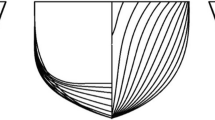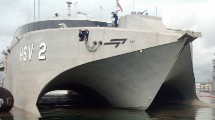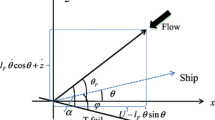Abstract
In this study, numerical simulations for the prediction of ship motions and added resistance of a high-speed trimaran equipped with and without T-foil and stern flap for various wave conditions in regular head and oblique waves were investigated by means of unsteady Reynolds-averaged Navier–Stokes (RANS) method. The numerical methods used in the CFD approach were presented. Grid convergence tests were conducted to determine an optimal mesh system for the calculations of motions and added resistance of the trimaran in both head and oblique waves. Numerical simulations were performed to predict added resistance and ship motions of the trimaran vehicle, and the nonlinearity of the forces and moments acting on the trimaran was investigated. Unsteady wave patterns and time histories of the added resistance and ship motions were simulated and analyzed. The relationship between the added resistance and vertical ship motions was studied in detail, and the nonlinearity of the added resistance and ship motions with varying wave steepness was investigated. The influence of the T-foil on seakeeping performance of the trimaran was investigated, and the effect of various wave steepnesses on ship motions of the trimaran and the forces acting on the T-foil was analyzed.




















Similar content being viewed by others
References
Davis MR, Holloway DS (2015) A comparison of the motions of trimarans, catamarans and monohulls. Aust J Mech Eng 4:183–195
Bertorello C, Bruzzone D, Cassella P et al (2001) Trimaran model test results and comparison with different high-speed craft. Practical Design of Ships and Other Floating Structures 1:143–149
Hebblewhite K, Sahoo PK, Doctors LJ (2007) A case study: theoretical and experimental analysis of motion characteristics of a trimaran hull form. Ships Offshore Struct 2:149–156
Vakilabadi KA, Khedmati MR, Seif MS (2014) Experimental study on heave and pitch motion characteristics of a wave-piercing trimaran. Transactions of FAMENA 38:13–26
Wang SM, Ma S, Duan WY (2018) Seakeeping optimization of trimaran outrigger layout based on NSGA-II. Appl Ocean Res 78:110–122
Fang CC, Chan HS (2007) An investigation on the vertical motion sickness characteristics of a high-speed catamaran ferry. Ocean Eng 34:1909–1917
N. Salvesen, E.O. Tuck, O.M. Faltinsen, Ship Motions and Sea Loads. Trans. Soc. Naval Archit. Mari. Eng. 78 (1970).
O.M. Faltinsen, R. Zhao, N. Umeda, Numerical prediction of ship motions at high forward speed [and discussion]. Philosophical Transactions of the Royal Society A Mathematical Physical and Engineering Sciences 334 (1991).
W.Y. Duan, D.B. Huang, D. Hudson, et al., Comparison of two seakeeping prediction methods for high-speed multihull vessels. In: Proceedings of the 6th International Conference on Fast Sea Transportation, Southampton, (2001).
S. Ma, 2.5d Computational Method for Ship Motions and Waves Loads of High-Speed Ships, Ph.D. thesis. Harbin Engineering University, Harbin, China (in Chinese), (2005).
W.Y. Duan, S.M. Wang, S. Ma, Verification of application of the 2.5D method in high-speed trimaran vertical motion and added resistance prediction. Ocean Eng. 187 (2019) 106177.
S. Tavakoli, R.N. Bilandi, S. Mancini, et al. Dynamic of a planning hull in regular waves: Comparison of experimental, numerical and mathematical methods. Ocean Eng. 217(2020) 107959.
Simonsen CD, Otzen JF, Joncquez S et al (2013) EFD and CFD for KCS heaving and pitching in regular head waves. J Mar Sci Technol 18:435–459
Guo BJ, Steen S, Deng GB (2012) Seakeeping prediction of KVLCC2 in head waves with RANS. Appl Ocean Res 35:56–67
Tezdogan T, Demirel YK, Kellett P et al (2015) Full-scale unsteady RANS CFD simulations of ship behavior and performance in head seas due to slow steaming. Ocean Eng 97:186–206
Seo S, Park S, Koo BY (2017) Effect of wave periods on added resistance and motions of a ship in head simulations. Ocean Eng 137:309–327
Lee YG, Kim C, Park JH et al (2019) Numerical simulations of added resistance in regular head waves on a container ship. Brodogradnja 70:61–86
J.W. Kim, J. O’Sullivan, A. Read (2012) Ringing analysis on a vertical cylinder by Euler Overlay Method. In: Proceedings of the ASME 31st international conference on ocean, offshore and arctic engineering, vol 4, pp 855–866.
Kim M, Hizir O, Turan O et al (2017) Numerical studies on added resistance and motions of KVLCC2 in head seas for various ship speeds. Ocean Eng 140:466–476
Hizir O, Kim M, Turan O et al (2019) Numerical studies on non-linearity of added resistance and ship motions of KVLCC2 in short and long waves. Int J Nav Archit Ocean Eng 11:143–153
Wu CS, Zhou DC, Gao L et al (2011) CFD computations of ship motions and added resistance for a high-speed trimaran in regular head waves. Int J Nav Archit Ocean Eng 3:105–110
P. Ghadimi, A. Nazemian, A. Ghadimi, Numerical scrutiny of the influence of side hulls arrangement on the motion of a Trimaran vessel in regular waves through CFD analysis. J. Braz. Soc. Mech. Sci. Eng. 41 (2019). https://doi.org/10.1007/s40430-018-1505-x
Esteban S, Giron-Sierra JM, Andres-Toro BD et al (2005) Fast ships models for seakeeping improvement studies using flaps and t-foil. Math Comput Model 41:1–24
Zong Z, Sun YF, Jiang YC (2019) Experimental study of controlled T-foil for vertical acceleration reduction of a trimaran. J Mar Sci Technol 24:553–564
M.De Biase, V. Basile, S. Mancini, Stern flap solution to contain the speed performance loss due to the ship weight growth: an application on the "De La Penne" Destroyer Class, High Speed Marine Vehicles Symposium 2020. https://ebooks.iospress.nl/doi/https://doi.org/10.3233/PMST200022.
K.W. Song, C.Y. Guo, C. Wang, et al., Numerical analysis of the effects of stern flaps on ship resistance and propulsion performance. Ocean Eng. 193(2019), 106621.
User Guide. 2020. STAR-CCM+ version 2020.1. SIEMENS Simcenter.
International Towing Tank Conference (ITTC), (2011b). Practical guidelines for ship CFD applications. In: Proceedings of the 26th ITTC.
A. Li, Y.B. Li, D.P. Zhang, et al., Numerical study on hydrodynamic coefficients and longitudinal motions of trimaran in head seas for various wave slopes. Journal of the Brazilian Society of Mechanical Sciences and Engineering. 42(2020).
Li A, Li YB (2019) Numerical and experimental study on seakeeping performance of a high-speed trimaran with T-foil in head waves. Pol Marit Res 103:65–77
I.B. Celik, U. Ghia, P.J. Roache, et al., Procedure for estimation and reporting of uncertainty due to discretization in CFD applications. J. Fluids Eng. Trans. ASME 130 (2008) 078001.
Stern F, Wilson R, Shao J (2006) Quantitative V&V of CFD simulations and certification of CFD codes. Int J Numer Methods Fluids 50:1335–1355
De Luca F, Mancini S, Miranda S et al (2016) An extended verification and validation study of CFD simulations for planning hulls. J Ship Res 60:101–118
Kim YC, Kim KS, Kim J et al (2017) Analysis of added resistance and seakeeping responses in head sea conditions for low-speed full ships using URANS approach. Int J Archit Ocean Eng 9:641–654
Kim M, Hizir O, Turan O et al (2017) Estimation of added resistance and ship speed loss in a seaway. Ocean Eng 141:465–476
ITTC recommendations, 2014. 7.5–03–02–03, Practical Guidelines for Ship CFD Applications, in: ITTC – Recommended Procedures and Guidelines, 2014.
Ozdemir YH, Barlas B (2017) Numerical study of ship motions and added resistance in regular incident waves of KVLCC2 model. Int J Archit Ocean Eng 9:149–159
MEPC 6522 (2013) interim guidelines for determining minimum propulsion power to maintain the maneuverability of ships in adverse conditions. IMO, London
Nakamura S, Naito S (1977) Propulsive performance of a container ship in waves. J Soc Nav Archit Jpn 15:24–48
Acknowledgements
The paper was supported by the National Natural Science Foundation of China (Grant No. 51979157) and the Natural Science Foundation of Shanghai, China (Grant No. 19ZR1422500).
Author information
Authors and Affiliations
Corresponding author
Ethics declarations
Conflict of interest
No potential conflict of interest was reported by the authors.
Additional information
Technical Editor: Monica Carvalho.
Publisher's Note
Springer Nature remains neutral with regard to jurisdictional claims in published maps and institutional affiliations.
Rights and permissions
About this article
Cite this article
Li, Y., Li, A., Gong, J. et al. Numerical investigation on added resistance and motions of a high-speed trimaran equipped with T-foil and stern flap in regular head and oblique waves for varying wave steepness. J Braz. Soc. Mech. Sci. Eng. 43, 451 (2021). https://doi.org/10.1007/s40430-021-03177-0
Received:
Accepted:
Published:
DOI: https://doi.org/10.1007/s40430-021-03177-0




